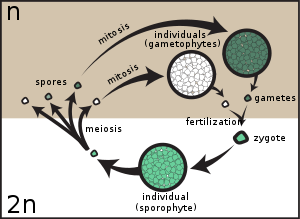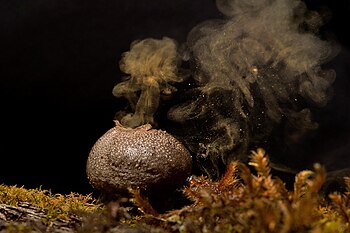Spore
In biology, the term spore designates a unicellular or multicellular microscopic body that is formed for purposes of dispersal and long-term survival (dormant) under adverse conditions, and is generally a haploid cell. In many eukaryotic beings, it is a fundamental part of their reproduction, originating a new organism by dividing by mitosis (especially in fungi) or meiosis (plants), without having to merge with another cell, while in some bacteria it is instead a single cell. dormant stage, resistant to desiccation and for non-reproductive survival purposes. The term derives from the Greek σπορά (sporá), "seed".
The spore is an important element in the biological life cycles of plants, fungi, algae and some protozoa, which usually produce spores in structures called sporangia. In plants, the spores are the gametophytes within their life cycle and at the same time allow the dispersal of the propagules. Most fungi produce spores; those that do not are called asporogenic fungi.
Classification of spores
Spores can be classified according to their function, structure, origin of the life cycle or by their mobility:
Because of its function
Diaspores are dispersal units of fungi, mosses, and some other plants. In fungi, chlamydospores are thick-walled multicellular spores resulting from asexual reproduction and zygospores are the sexual part, since they divide by meiosis when conditions for germination are achieved. Hypnozygotes of zygomycete fungi are produced sexually and can give rise to an asexual conidiospore (“zygosporangium”).
Due to its origin during the life cycle
A meiospore is the product of meiosis (the critical cytogenetic stage of sexual reproduction), which means that it is haploid and will give rise to a haploid cell or individual. This is characteristic of the life cycles of plants and algae.
A mitospore is produced by a sporulation mechanism and is propagated asexually as a result of mitosis. Most fungi produce mitospores.
Motility
Motility is the ability to move autonomously and spontaneously. The spores are divided according to whether they can move or not. The zoospore can move by means of one or more flagella and can be found in some algae and fungi. Meanwhile, the autospore cannot move and does not have the potential to develop any flagellum. Ballistospores are actively discharged from the fruiting body (such as the mushroom). The statismospore is not actively discharged from the fruiting body, as in the puffball.
Plant spores
Plants are characterized by having a life cycle with alternating generations, a sporophytic and a gametophytic generation. Certain cells of the sporophytes produce haploid spores by meiosis. These spores will develop into gametophytes. An example is the gametophyte of the taller vascular plants (angiosperms and gymnosperms), which are meiospores of two types:
- Microspora: Male Spore that gives rise to pollen
- Macrospora: Female fodder that gives rise to eggs, which are found within the flower and cones of the conifer; such plants achieve dispersion through the seed.
Diasporas
In the case of vascular plants such as ferns, anemochore dispersal provides great spore distribution capacity. Also, spores are less amenable to animal predation than seeds because they contain almost no food reserves, but are more amenable to predation by fungi and bacteria. Its main advantage is that, of all the forms of reproduction, spores require less energy and materials to produce. The spores of vascular plants are always haploid, and may be isospores (homospores) or heterospores. Heterospores, present for example in selaginellas, isoetes and some aquatic ferns, produce spores of two sizes: the largest spores (megaspores) produce female gametophytes and the smallest (microspores) produce male gametophytes. The spores can be of two types depending on the development marks: monolet or trilet. In monolets, there is a single raised line on the spore indicating the axis along which the spore mother cell divided. In trilet spores, the four spores share a common origin, are arranged in a tetrahedron, and come into contact on three faces separated by three carinae radiating from a central (Y-shaped) point.
Spores of algae
Highly diverse spores and other propagules play a central role in most multicellular algae, affecting their ecology. The oldest fossils are sporangia of red algae from 1.2 billion years ago. Spores occur on green algae, rhodophytes, heterocontophytes, and chlorarachniophytes.
Mushroom spores
In fungi and pseudofungi, they are often classified by their spore-producing structures. These spores usually have characteristics specific to a particular taxon. Main types of spores:
- Ascospora: Produced in nuts, specifically in ascomitants.
- Basidiumspora: Produced in the basidiums.
- Condom: Asexual spores produced in the conidophores of the imperfect fungi (deuteromicetes).
- Ecidiospora: Produced for example in Pucciniawhere there is alternation with the production of basidiosporas.
- Sporangiospora: Like those produced by the sporangios of many zigomicetos.
- GlomersporaРусский
- Teliospora: Produced in the basidiums of some basidiums.
- Zigospora: Produced in zigosporangios of zigomicetos.
- Zoospora: Flagellated spores produced by primitive fungi such as quitrides and opistosporidios.
In pseudofungi
The oospores are part of the sexual cycle of oomycetes.
Bacterial spores
Bacterial spores are characteristic of certain bacteria, which usually develop a single spore per cell. In this case the formation of spores is not a definitive type of reproduction; these cells can resist destruction in a hostile or unfavorable environment. There are various terrestrial bacteria, especially Gram positive, which can be induced to the spore state through a mechanism called sporulation, thus achieving resistance against desiccation, crushing, nutrient shortage, cold, heat, radiation (UV, X, γ), salt, oxidants, disinfectants, extreme pH, etc., due to its hard and impermeable cover. It is an inactive or latent state in which it does not grow and there is no reproduction, since a single spore is produced from a bacterium. Its activation under favorable conditions is called germination. There are 3 types of bacterial spores:
- Endospora: It is typical of several firmicutes bacteria and forms inside the cell. These include greater medical importance Bacillus and Clostridium. An example is the endosporas that were used in carbunco attacks in 2001.
- Exospora: It is characteristic of some actinobacterials and forms externally by geming a bacterial filamentous mycelium, as in Actinomyces and Streptomycesanalogous to the condoms of the fungi. They are less resistant than endobacteria and their structure is also very different.
- Acineto: It is typical of some cyanobacteria, forming by increase of its size, density, food reserve and thickening of its wall, especially in Nostocales and Stigonematales. They are less resistant than stents but protect well from winter freezing.
Contenido relacionado
Isachne
Cryptophyta
Aegilops



